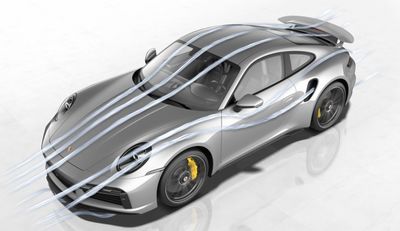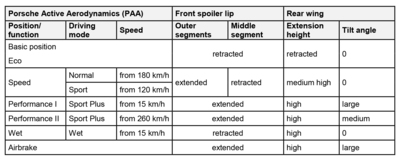New 911 Turbo S: the ideal aerodynamic setup for every driving situation
More powerful, dynamic and comfortable than ever before: the new 911 Turbo S sets new standards in many areas. That is also true for the adaptive aero-dynamics, which Porsche has further enhanced in its flagship 911.
Porsche Active Aerodynamics (PAA) adapts the aerodynamic characteristics of the vehicle even more precisely to the driving situation, speed and selected driving mode. PAA celebrated its world premiere in the previous generation of the 911 Turbo launched in 2014. All model lines from the 718 through to the Panamera and Taycan now feature active aero-dynamic elements.
“No other sports car reacts to different situations with such aerodynamic flexibility as the new 911 Turbo S. We aerodynamic engineers are normally faced with a dilemma: a low drag coefficient is desirable for maximum speed and low consumption, while a high downforce is advantageous for driving dynamics. However, the two characteristics contradict each other,” explains Dr Thomas Wiegand, Head of Aerodynamics Development at Porsche. “PAA resolves the conflicts between these different aerodynamic goals. The comprehensive expansion of the intelligent system in the 911 Turbo S makes it possible to achieve a much larger spread between the aerodynamic configurations for optimum driving dynamics and minimum drag. What is more, there is increased potential for the aerodynamic components to support specific driving dynamics demands in every driving situation.”
The active cooling air flaps are new. Together with the variable front spoiler lip as well as the extending and tilting rear wing, the new top-of-the-range model therefore features three active aerodynamic components. On top of the basic aerodynamic configurations of the 911 Turbo, namely PAA Speed and PAA Performance, this now permits realisation of an Eco configuration.
PAA has also been extended to include a Wet Mode function, which moves the aerodynamic balance towards the rear axle for greater driving stability in wet road conditions, as well as the airbrake function, which produces higher drag and greater downforce in the event of full braking at high speed and therefore results in a shorter braking distance and greater driving stability. PAA is also used for adaptation to the changed air flow around the vehicle when the sliding roof or convertible top is open. This means that there are a total of eight different aerodynamic configurations, which are each described by a specific combination of the active aerodynamic components.




